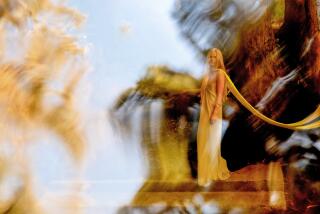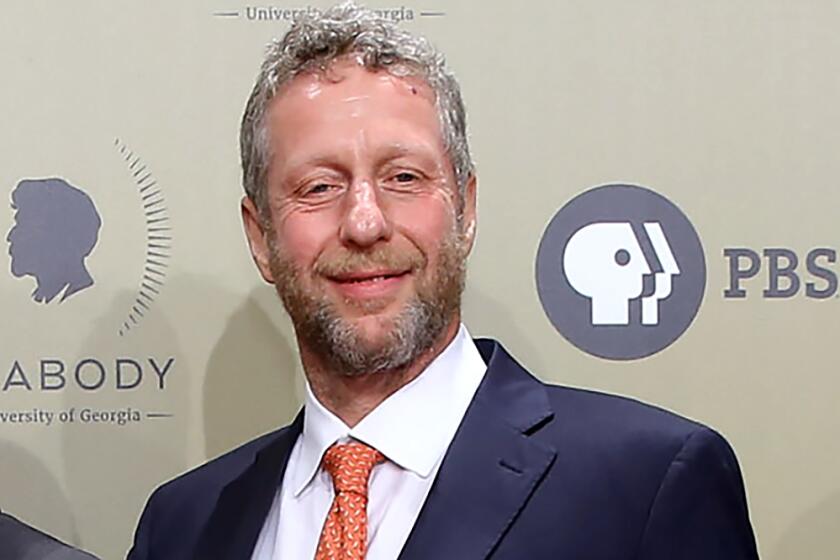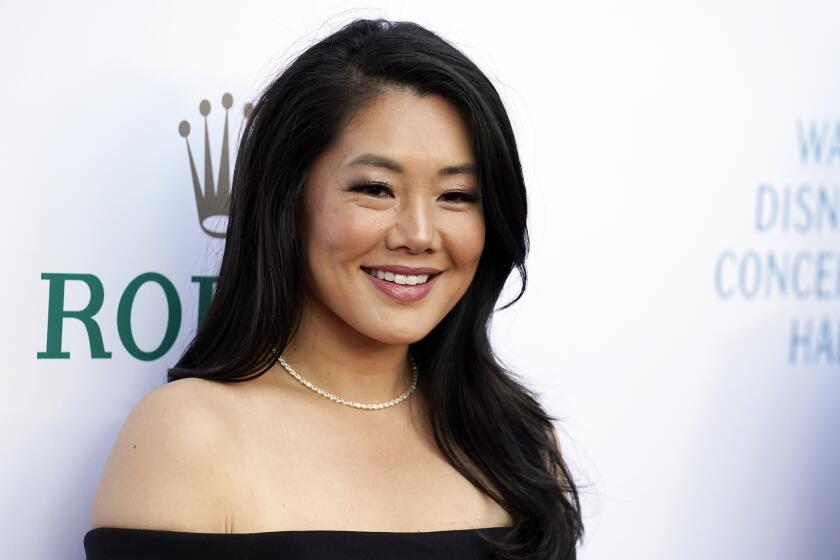Kurt Andersen, visionary in residence
For a visionary, Kurt Andersen is keeping it pretty low-key.
The writer is sitting quietly in blazer and jeans in front of a class at Pasadena’s Art Center College of Design. He’s not just a visiting professor but the school’s visionary in residence.
The class’ students, with their retro hats, black duds and horizontal stripes, could be making a French New Wave film or rehearsing the latest edition of the Yeah Yeah Yeahs. They’re actually putting together a publication called Wrap and Andersen is advising.
They display their pages -- one spread involves a play on the names Rimbaud and Rambo, another shows Jesus riding a unicorn -- while two design professors offer critiques. Mostly, Andersen listens intensely, gazes closely at the pages and offers brief comments like “Works for me” and “It looks cool, I’ve gotta say” in a flat Nebraska voice known to listeners of his public radio show “Studio 360.”
Andersen has written an essay to kick off the publication. “The theme I picked,” he says, alluding to Mark Twain, “is that history doesn’t repeat, but it rhymes.” He likens America in 2009 to Britain circa 1909 and calls China “the new us.”
To an outsider, the class seems detail-obsessed and hardly dynamic. But part of what Andersen does well is listen, and his New York magazine columns on politics and culture are often the result of what would be called great cultural eavesdropping. These days, his undergraduate training studying economic history makes him an apt guide to the moment.
“Kurt is so valuable because he’s such a keen observer of culture,” says Nik Hafermaas, Art Center’s acting provost. “He puts phenomena in historical context, which is very important for our students: It allows us to reflect on what we do.”
Nicolette Vilar, a 27-year-old senior from Los Angeles, describes Andersen’s role in the publications class as “an overall thought stimulator. He more than anything pushed us to come up with our own ideas,” she said. “The class discussions were very free-flowing and fun. As a teacher, he let us think for ourselves.”
Andersen, 54, says he doesn’t have a strategy or methodology -- “I just keep my eyes and ears open and try to figure out exactly what I think and why I think it” -- but he’s the rare scribe who can write a convincing big-picture piece about where the culture is headed. And where it’s headed now is right up his alley.
The view from here
Rather than being a bold or radical thinker -- OK, a visionary -- the Omaha-born Andersen is really an interpreter, a synthesizer, a historian of the now. (He’s also, with his 2007 novel “Heyday,” an actual historical novelist.) The “we” he uses in his columns lacks Pauline Kael’s insistent pushing of her readers: He’s a wry, cool-voiced assessor, not a cultural crusader. Part of what he tries to do, in his radio show and journalism, is provide shared reference points -- whether within rock music or fine art -- that add up to American culture in all its variety.
He’s also smart enough to express ambivalence for his choice as the second-ever visionary, following cyberpunk author Bruce Sterling. (“In 2005,” Sterling wrote, “I had the coolest job title in the world.”)
Relaxing the day after the publications class at a shaded picnic table, Andersen talks about what he’s doing at the college to earn his keep. He’s spent the morning speaking to students and faculty in the school’s auto design program. He’s looking for material for his radio show, which comes no closer to L.A. than Oxnard or Palm Springs.
“It’s a funny thing,” he says. “I’ve never quite been in this position: how flattering to be called the visionary in residence. How embarrassing to have to tell people I’m the visionary in residence.”
He’s advised a studio on local social problems, where students were charged with solving a pressing issue as well as marketing their solution. He put together a lecture series called “The Big Picture” that’s brought writers and thinkers to campus, including Steven Johnson of “Everything Bad Is Good for You.” And he helped moderate a summit on sustainable mobility, a big issue on campus. “There is no job description -- I kind of make it up as I go along.”
More broadly, he’s trying to immerse himself in the life of the school as well as Greater Los Angeles. He moved to New York, where he co-founded Spy magazine in 1986, soon after graduating from Harvard, and he’s not been out of the city for more than a few weeks since.
Immersed in SoCal
He jokes that he’s a “New York snob” in some ways but not in regard to Southern California. He’s enjoyed the chance to live close to nature, dwelling with his wife in a rented Rudolph Schindler house in Studio City. Thanks to traffic, he’s listened to more radio than in any other period of his life. He has taken in a wide range of local culture, enjoying a tour of modernist architecture, LACMA’s “Art of Two Germanys / Cold War Cultures” show, “The Nigerian Spam Scam Scam” at the Steve Allen Theater and the Grand National Roadster Show at the L.A. County Fairplex in Pomona.
He’s been enjoying restaurants like Osteria Mozza, Lou and Palate Food+Wine and sent enthusiastic tweets about his visit: “once they figure out teleportation (and, ok, preventing quakes and wildfires),” he wrote in one, “there’ll be no reason not to live in southern california.”
He’s been dazzled by the rain and struck that Hollywood liberals are as stubbornly inflexible as he’d been told.
Andersen had a recent cover story in Time magazine that expanded on some of the ideas he’s been speaking and writing about at Art Center.
Previous decades have ended more or less on schedule. “But in all salient respects, ‘the ‘80s -- Reaganism’s reshaping of the political economy, the thrall of the PC, the vertiginous rise in the stock market -- did not end,” he writes. “The ‘80s spirit endured through the ‘90s and the 2000s, all the way until the fall of 2008, like an awesome winning streak in Vegas that went on and on and on. American-style capitalism triumphed, and thanks to FedEx and the Web, delayed gratification itself came to seem quaint and unnecessary.”
The piece is a portrait of the world just ended as well as a sketch of what might be coming next. “The vocabulary of addiction recovery could come in handy just now,” he writes in Time. “We are like substance abusers coming off a long bender, hitting bottom (we can only hope) and taking the messes we’ve made as a sobering wake-up call.”
One thing that troubles him is the loss of serendipitous discoveries as the Internet replaces print with more self-directed kinds of information.
With his writing and his radio program, he tries to provide a kind of enlightened canon or common language of the kind the country has been losing since the late ‘60s. The cultural left made the mistake in spreading the idea, he says, “that what’s relevant to you is what’s important, even to the point of making up our own facts. And we’ve seen it come back to bite us, with things like intelligent design.”
The move of serious culture to the margins of American society is hard to mistake, he says. “The age in which any novel or novelist can be really central to the American conversation passed away a long time ago, with the Updike-Mailer-Roth generation. Jonathan Lethem and Jonathan Franzen are great writers, but I’m sure they will agree, they’re not going to be on the cover of Time magazine.”
For all this, he feels there are good things in store for the culture as well as for him personally. Working in a publications class made him pine for his days running magazines. “I have nostalgic, elegiac feelings,” he allowed. “But I’m more curious to see what’s gonna happen next. I’m certainly not remotely terrified. If you’re 22, you might be on the ground floor of something new, whatever form those new things take.”
During his time here he’s begun a novel, set in the 1960s and the present.
He’s also working on the pilot for a 30-minute show for HBO. The program, which he’s working on with screenwriter Lawrence O’Donnell, will loosely resemble his 1999 novel, “Turn of the Century.” That novel offered one of the last major literary glimpses of the fat-and-happy New York media world just before 9/11.
“This complacent, self-regarding world at a point of implosion . . . “ Andersen says. “Sounds like comedy to me!”
More to Read
The biggest entertainment stories
Get our big stories about Hollywood, film, television, music, arts, culture and more right in your inbox as soon as they publish.
You may occasionally receive promotional content from the Los Angeles Times.






